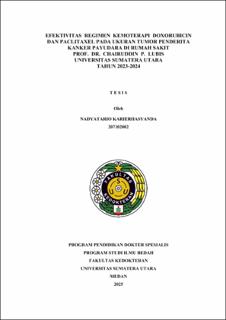| dc.description.abstract | Introduction: Breast cancer (BC) is a leading cause of cancer mortality in women globally, with rising incidence in Indonesia. Neoadjuvant chemotherapy (NAC), particularly the combination of doxorubicin and paclitaxel, is effective in locally advanced BC for reducing tumor size, lowering cancer stage, and improving breast-conserving surgery rates. This study evaluates the efficacy of this regimen in tumor size reduction among BC patients treated at Prof. Dr. Chairuddin P. Lubis Hospital, Universitas Sumatera Utara.
Methods: This observational analytic study utilized a cross-sectional design with secondary data from medical records of BC patients treated with doxorubicin and paclitaxel chemotherapy between January 2023 and December 2024. Inclusion criteria included locally advanced BC, histopathological confirmation, and completion of at least three chemotherapy cycles. Tumor size reduction was evaluated using WHO RECIST criteria, and data were analyzed with the Chi-square test.
Results: Sixty patients (mean age 48.28 ± 8.89 years) were included, with most being stage III (58.3%), grade 2 (50%), and histologically categorized as no special type (75%). Tumor size decreased significantly from 6.52 ± 3.62 cm to 4.57 ± 2.48 cm (p < 0.001). Based on WHO criteria, 36 patients (60%) achieved partial response, while 24 (40%) had stable disease. No cases of complete response or progressive disease were observed. A significant association between chemotherapy and tumor size reduction was identified (p < 0.001).
Discussion: The combination of doxorubicin and paclitaxel demonstrated significant efficacy in tumor size reduction for advanced BC, particularly in non-special type histology. The findings align with previous studies but underscore the need for personalized treatment approaches for subtypes such as triple-negative BC, which may exhibit lower response rates.
Conclusion: The doxorubicin and paclitaxel regimen effectively reduced tumor size in patients with locally advanced BC. While it is suitable for non-special type and stage III BC, personalized strategies should be explored for improving outcomes in specific subtypes. | en_US |


